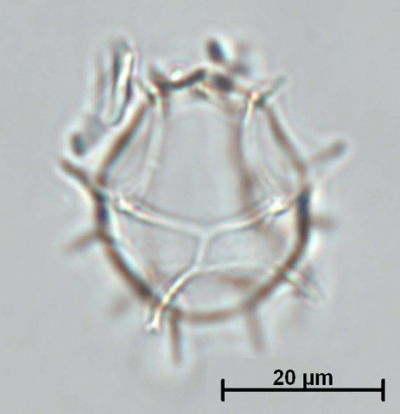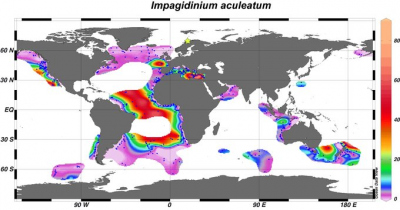Die Inhalte dieser Seite sind leider nicht auf Deutsch verfügbar.
Seitenpfad:
- Modern Dinocyst Key
- transparent cysts
- Paratabulation reflected by septa
- variable septa
- Impagidinium aculeatum
Impagidinium aculeatum
Zonneveld, K.A.F. and Pospelova V. (2015). A determination key for modern dinoflagellate cysts. Palynology 39 (3), 387- 407.

dorsal view
photo: Karin Zonneveld
photo: Karin Zonneveld
cross section
photo: Karin Zonneveld
photo: Karin Zonneveld
ventral view
photo: Karin Zonneveld
photo: Karin Zonneveld
Field Characteristics
Impagidinium aculeatum (Wall 1967) Lentin et Williams 1981
Field characteristics:
Small proximochorate ovoid cyst with a small apical protuberance and a finely microgranulate wall surface. Tabulation is defined by well-expressed low sutural septa with exception of the sulcal area. The height of the septa increases at the plate junctions. Archeopyle is precingular (type P). Precingular plate 5" is very narrow.
Dimensions: ranges from 28 to 38 µm, height of septa: ~9 µm.
Motile affinity: unknown
Motile affinity: unknown
Stratigraphic range: Oligocene to Recent.
Comparison with other species:
Impagidinium aculeatum has smooth septa that are higher at triple junctions and the apical boss.. This gives the specimens a star-shaped appearance. The speta are not cavate, have no holes or other ornamentation. Tabulation is welll expressed with the exception of the sulcal area. The archeopyle is often observed.
Field characteristics:
Small proximochorate ovoid cyst with a small apical protuberance and a finely microgranulate wall surface. Tabulation is defined by well-expressed low sutural septa with exception of the sulcal area. The height of the septa increases at the plate junctions. Archeopyle is precingular (type P). Precingular plate 5" is very narrow.
Dimensions: ranges from 28 to 38 µm, height of septa: ~9 µm.
Motile affinity: unknown
Motile affinity: unknown
Stratigraphic range: Oligocene to Recent.
Comparison with other species:
Impagidinium aculeatum has smooth septa that are higher at triple junctions and the apical boss.. This gives the specimens a star-shaped appearance. The speta are not cavate, have no holes or other ornamentation. Tabulation is welll expressed with the exception of the sulcal area. The archeopyle is often observed.
Geographic Distribution
Geographic distribution based on :
Zonneveld et al., 2013. Atlas of modern dinoflagellate cyst distribution based on 2405 datapoints. Review of Palaeobotany and Palynology, v. 191, 1-197
Zonneveld et al., 2013. Atlas of modern dinoflagellate cyst distribution based on 2405 datapoints. Review of Palaeobotany and Palynology, v. 191, 1-197
Impagidinium aculeatum has a widespread distribution outside of the Arctic and Antarctic and low salinity waters. Although it has been reported from oligotrophic to eutrophic environments and shallow-water coastal regions to the central oceans, highest relative abundances occur in central oceanic oligotrophic environments that are characterized by well-ventilated bottom waters.

Distribution:
Impagidinium aculeatum is observed between the arctic sub-tropical front and the antarctic polar-front. Although the species is observed from coastal sediments to the open ocean, highest abundances up to 80% occur in the sub-tropical, tropical and equatorial central oceans.
Environmental parameters:
SST: -1.6 - 29.6°C (winter - autumn). SSS: 31.0-39.4 (spring - autumn) except for one North Atlantic site where SSS: 19.6 (spring). [P]: 0.06 - 1.87 μmol/l, [N]: 0.04 - 26.4 μmol/l, chlorophyll-a: 0.05 - 11.5 ml/l, bottom water [O2]: 1.3 - 6.9 ml/l except for one site where bottom water [O2]: 0.33
Abundances > 50% occur when SST: 31.0 - 26.7°C (spring - summer) and [P]: 0.06 - 0.27 μmol/l, [N]: 0.04 - 2.8 μmol/l and Chlorophyll-a: 0.05 - 0.43 ml/l. Although it occurs at sites with anoxic bottom waters relative abundances increase with increasing bottom water oxygen concentrations
Comparison with other records:
Apart from the records included in this Atlas, I. aculeatum has been documented from a fjord in the northern part of Norway (Rørvik et al., 2009). Although this fjord is not influenced by glaciers, salinities can be strongly reduced seasonally and vary between 11 - 34.6. Although it occurs at sites with winter SST: < 0°C, it is absent from sites that are covered seasonally by sea ice (Mudie, 1992; de Vernal and Hillaire-Marcel, 2000; Radi and de Vernal, 2008). Highest relative abundances occur in oligotrophic environments. However, sediment trap studies have shown that its cyst production increases with increasing nutrient availability and bioproduction in the upper waters (Zonneveld and Brummer, 2000; Susek et al., 2005; Zonneveld et al., 2010).
Impagidinium aculeatum is observed between the arctic sub-tropical front and the antarctic polar-front. Although the species is observed from coastal sediments to the open ocean, highest abundances up to 80% occur in the sub-tropical, tropical and equatorial central oceans.
Environmental parameters:
SST: -1.6 - 29.6°C (winter - autumn). SSS: 31.0-39.4 (spring - autumn) except for one North Atlantic site where SSS: 19.6 (spring). [P]: 0.06 - 1.87 μmol/l, [N]: 0.04 - 26.4 μmol/l, chlorophyll-a: 0.05 - 11.5 ml/l, bottom water [O2]: 1.3 - 6.9 ml/l except for one site where bottom water [O2]: 0.33
Abundances > 50% occur when SST: 31.0 - 26.7°C (spring - summer) and [P]: 0.06 - 0.27 μmol/l, [N]: 0.04 - 2.8 μmol/l and Chlorophyll-a: 0.05 - 0.43 ml/l. Although it occurs at sites with anoxic bottom waters relative abundances increase with increasing bottom water oxygen concentrations
Comparison with other records:
Apart from the records included in this Atlas, I. aculeatum has been documented from a fjord in the northern part of Norway (Rørvik et al., 2009). Although this fjord is not influenced by glaciers, salinities can be strongly reduced seasonally and vary between 11 - 34.6. Although it occurs at sites with winter SST: < 0°C, it is absent from sites that are covered seasonally by sea ice (Mudie, 1992; de Vernal and Hillaire-Marcel, 2000; Radi and de Vernal, 2008). Highest relative abundances occur in oligotrophic environments. However, sediment trap studies have shown that its cyst production increases with increasing nutrient availability and bioproduction in the upper waters (Zonneveld and Brummer, 2000; Susek et al., 2005; Zonneveld et al., 2010).



